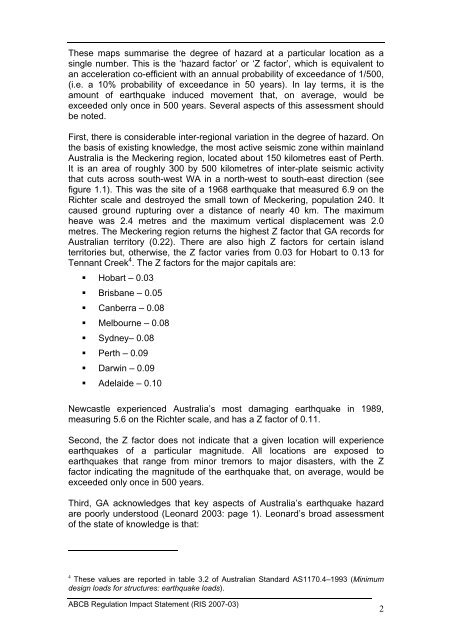PDF | 2 MB - Australian Building Codes Board
PDF | 2 MB - Australian Building Codes Board
PDF | 2 MB - Australian Building Codes Board
Create successful ePaper yourself
Turn your PDF publications into a flip-book with our unique Google optimized e-Paper software.
These maps summarise the degree of hazard at a particular location as a<br />
single number. This is the ‘hazard factor’ or ‘Z factor’, which is equivalent to<br />
an acceleration co-efficient with an annual probability of exceedance of 1/500,<br />
(i.e. a 10% probability of exceedance in 50 years). In lay terms, it is the<br />
amount of earthquake induced movement that, on average, would be<br />
exceeded only once in 500 years. Several aspects of this assessment should<br />
be noted.<br />
First, there is considerable inter-regional variation in the degree of hazard. On<br />
the basis of existing knowledge, the most active seismic zone within mainland<br />
Australia is the Meckering region, located about 150 kilometres east of Perth.<br />
It is an area of roughly 300 by 500 kilometres of inter-plate seismic activity<br />
that cuts across south-west WA in a north-west to south-east direction (see<br />
figure 1.1). This was the site of a 1968 earthquake that measured 6.9 on the<br />
Richter scale and destroyed the small town of Meckering, population 240. It<br />
caused ground rupturing over a distance of nearly 40 km. The maximum<br />
heave was 2.4 metres and the maximum vertical displacement was 2.0<br />
metres. The Meckering region returns the highest Z factor that GA records for<br />
<strong>Australian</strong> territory (0.22). There are also high Z factors for certain island<br />
territories but, otherwise, the Z factor varies from 0.03 for Hobart to 0.13 for<br />
Tennant Creek 4 . The Z factors for the major capitals are:<br />
• Hobart – 0.03<br />
• Brisbane – 0.05<br />
• Canberra – 0.08<br />
• Melbourne – 0.08<br />
• Sydney– 0.08<br />
• Perth – 0.09<br />
• Darwin – 0.09<br />
• Adelaide – 0.10<br />
Newcastle experienced Australia’s most damaging earthquake in 1989,<br />
measuring 5.6 on the Richter scale, and has a Z factor of 0.11.<br />
Second, the Z factor does not indicate that a given location will experience<br />
earthquakes of a particular magnitude. All locations are exposed to<br />
earthquakes that range from minor tremors to major disasters, with the Z<br />
factor indicating the magnitude of the earthquake that, on average, would be<br />
exceeded only once in 500 years.<br />
Third, GA acknowledges that key aspects of Australia’s earthquake hazard<br />
are poorly understood (Leonard 2003: page 1). Leonard’s broad assessment<br />
of the state of knowledge is that:<br />
4<br />
These values are reported in table 3.2 of <strong>Australian</strong> Standard AS1170.4–1993 (Minimum<br />
design loads for structures: earthquake loads).<br />
ABCB Regulation Impact Statement (RIS 2007-03)<br />
2
















